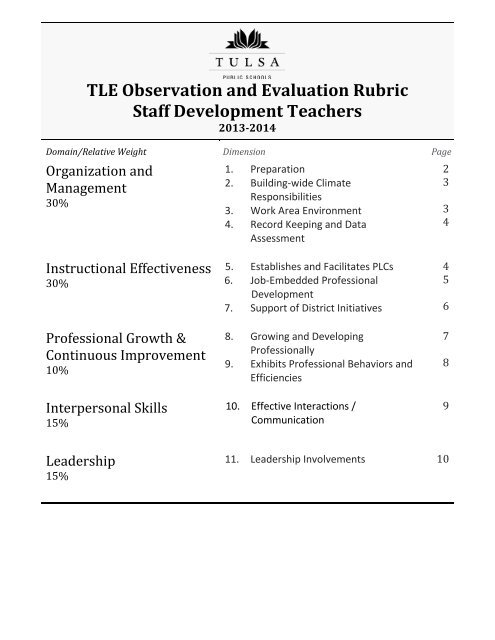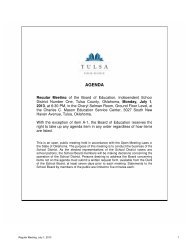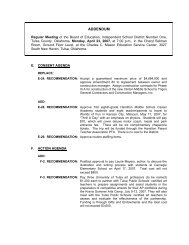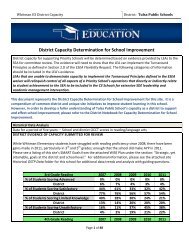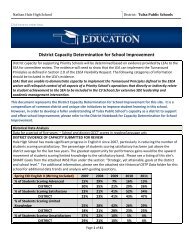TLE Observation and Evaluation Rubric Staff Development Teachers
TLE Observation and Evaluation Rubric Staff Development Teachers
TLE Observation and Evaluation Rubric Staff Development Teachers
Create successful ePaper yourself
Turn your PDF publications into a flip-book with our unique Google optimized e-Paper software.
<strong>TLE</strong> <strong>Observation</strong> <strong>and</strong> <strong>Evaluation</strong> <strong>Rubric</strong><br />
<strong>Staff</strong> <strong>Development</strong> <strong>Teachers</strong><br />
2013-2014<br />
Domain/Relative Weight Dimension Page<br />
Organization <strong>and</strong><br />
Management<br />
30%<br />
1. Preparation<br />
2. Building-wide Climate<br />
Responsibilities<br />
3. Work Area Environment<br />
4. Record Keeping <strong>and</strong> Data<br />
Assessment<br />
2<br />
3<br />
3<br />
4<br />
Instructional Effectiveness<br />
30%<br />
Professional Growth &<br />
Continuous Improvement<br />
10%<br />
Interpersonal Skills<br />
15%<br />
5. Establishes <strong>and</strong> Facilitates PLCs<br />
6. Job-Embedded Professional<br />
<strong>Development</strong><br />
7. Support of District Initiatives<br />
8. Growing <strong>and</strong> Developing<br />
Professionally<br />
9. Exhibits Professional Behaviors <strong>and</strong><br />
Efficiencies<br />
10. Effective Interactions /<br />
Communication<br />
4<br />
5<br />
6<br />
7<br />
8<br />
9<br />
Leadership<br />
15%<br />
11. Leadership Involvements 10
Domain: Organization <strong>and</strong> Management<br />
Dimension:<br />
1<br />
Preparation<br />
<strong>Staff</strong> <strong>Development</strong> Teacher plans development <strong>and</strong> delivery of assistance/ support/<br />
professional development relative to short <strong>and</strong> long term objectives.<br />
1<br />
Ineffective<br />
Does not plan for<br />
assistance/<br />
support/professional<br />
development that<br />
provides teachers<br />
with resources/ skills<br />
needed for<br />
implementation.<br />
Indicator No.<br />
2<br />
Needs Improvement<br />
Inconsistently plans for<br />
assistance/support/professional<br />
development that provides<br />
teachers with resources/skills<br />
needed for implementation.<br />
3<br />
Effective<br />
Plans for assistance/<br />
support/professional<br />
development that<br />
provides teachers<br />
with resources/skills<br />
needed for<br />
implementation.<br />
4<br />
Highly Effective<br />
Plans for assistance/<br />
support/professional<br />
development based<br />
on school data that<br />
provides teachers<br />
with resources/skills<br />
needed for<br />
implementation.<br />
5<br />
Superior<br />
Plans for assistance/<br />
support/prof. dev.<br />
based on school data<br />
that provides teachers<br />
with resources/skills<br />
needed for<br />
implementation on<br />
various dates/ times<br />
to meet the schedules<br />
of teachers.<br />
Does not ensure<br />
materials/resources<br />
needed for<br />
training/meeting are<br />
prepared <strong>and</strong><br />
available.<br />
Inconsistently ensures<br />
materials/resources needed for<br />
training/meeting are prepared<br />
<strong>and</strong> available.<br />
Ensures<br />
materials/resources<br />
needed for<br />
training/meeting are<br />
prepared <strong>and</strong><br />
available.<br />
Ensures an agenda/<br />
materials/resources<br />
needed for<br />
training/meeting are<br />
prepared <strong>and</strong><br />
available.<br />
Ensures an agenda/<br />
materials/resources<br />
needed for<br />
training/meeting are<br />
prepared <strong>and</strong><br />
available. Provides<br />
follow up materials/<br />
resources as needed.<br />
Does not create staff<br />
development<br />
opportunities for<br />
individuals, small<br />
groups, or large<br />
groups that model the<br />
use of effective<br />
planning <strong>and</strong><br />
instructional<br />
techniques.<br />
Inconsistently creates staff<br />
development opportunities for<br />
individuals, small groups, or<br />
large groups that model the use<br />
of effective planning <strong>and</strong><br />
instructional techniques.<br />
Creates staff<br />
development<br />
opportunities for<br />
individuals, small<br />
groups, or large<br />
groups that model the<br />
use of effective<br />
planning <strong>and</strong><br />
instructional<br />
techniques.<br />
Creates <strong>and</strong><br />
implements staff<br />
development<br />
opportunities for<br />
individuals, small<br />
groups, or large<br />
groups that model the<br />
use of effective<br />
planning <strong>and</strong><br />
instructional<br />
techniques.<br />
Uses research to<br />
create <strong>and</strong> implement<br />
staff development<br />
opportunities for<br />
individuals, small<br />
groups, or large<br />
groups that model the<br />
use of effective<br />
planning <strong>and</strong><br />
instructional<br />
techniques.<br />
Provides r<strong>and</strong>om staff<br />
development<br />
opportunities.<br />
Inconsistently matches staff<br />
development opportunities to<br />
staff’s professional<br />
development needs.<br />
Matches staff<br />
development<br />
opportunities to<br />
staff’s professional<br />
development needs;<br />
adapts professional<br />
development in<br />
response to staff<br />
input.<br />
Matches staff<br />
development<br />
opportunities to<br />
staff’s professional<br />
development needs<br />
based on school data;<br />
adapts professional<br />
development in<br />
response to staff<br />
input.<br />
Matches staff<br />
development<br />
opportunities to<br />
staff’s professional<br />
development needs<br />
based on school data<br />
<strong>and</strong> the WISE plan;<br />
adapts professional<br />
development in<br />
response to staff<br />
input.<br />
(c) 2013, Tulsa Public Schools<br />
2<br />
<strong>TLE</strong> SDT <strong>Evaluation</strong> <strong>and</strong> <strong>Observation</strong> <strong>Rubric</strong>
2<br />
Domain: Organization <strong>and</strong> Management<br />
Dimension: Building Wide Climate Responsibilities<br />
<strong>Staff</strong> <strong>Development</strong> Teacher contributes to building-wide positive climate.<br />
1<br />
Ineffective<br />
Does not participate in<br />
school projects <strong>and</strong><br />
initiatives that<br />
contribute to promoting<br />
orderly behavior<br />
throughout the school.<br />
2<br />
Needs Improvement<br />
Inconsistently<br />
participates in school<br />
projects <strong>and</strong> initiatives<br />
that contribute to<br />
promoting orderly<br />
behavior throughout<br />
the school.<br />
3<br />
Effective<br />
Regularly <strong>and</strong> routinely<br />
participates in school<br />
projects <strong>and</strong> initiatives<br />
that contribute to<br />
promoting orderly<br />
behavior throughout<br />
the school.<br />
4<br />
Highly Effective<br />
Provides professional<br />
development on<br />
classroom management<br />
techniques <strong>and</strong><br />
methods to promote<br />
orderly behavior<br />
throughout the school.<br />
5<br />
Superior<br />
Provides professional<br />
development on<br />
classroom management<br />
techniques <strong>and</strong><br />
methods to promote<br />
orderly behavior<br />
throughout the school<br />
<strong>and</strong> ensures teachers<br />
receive ongoing<br />
support.<br />
Does not follow the<br />
procedures, practices<br />
<strong>and</strong> guidelines outlined<br />
by the school, district,<br />
state <strong>and</strong> federal laws,<br />
intended to keep<br />
students healthy <strong>and</strong><br />
safe.<br />
Inconsistently follows<br />
the procedures,<br />
practices <strong>and</strong> guidelines<br />
outlined by the school,<br />
district, state <strong>and</strong><br />
federal laws, intended<br />
to keep students<br />
healthy <strong>and</strong> safe.<br />
Follows the procedures,<br />
practices <strong>and</strong> guidelines<br />
outlined by the school,<br />
district, state <strong>and</strong><br />
federal laws, intended<br />
to keep students<br />
healthy <strong>and</strong> safe.<br />
Follows <strong>and</strong> models the<br />
procedures, practices<br />
<strong>and</strong> guidelines outlined<br />
by the school, district,<br />
state <strong>and</strong> federal laws,<br />
intended to keep<br />
students healthy <strong>and</strong><br />
safe.<br />
Routinely follows <strong>and</strong><br />
models the procedures,<br />
practices <strong>and</strong> guidelines<br />
outlined by the school,<br />
district, state <strong>and</strong><br />
federal laws, intended<br />
to keep students<br />
healthy <strong>and</strong> safe.<br />
Domain: Organization <strong>and</strong> Management<br />
Dimension:<br />
3<br />
Work Area Environment<br />
<strong>Staff</strong> <strong>Development</strong> Teacher optimizes the environment to assure efficacy in professional<br />
learning/ support.<br />
1<br />
Ineffective<br />
Work area is not<br />
organized. The area is<br />
cluttered, not clean or<br />
safe. Traffic flow is<br />
poor <strong>and</strong> meeting<br />
opportunities are<br />
limited.<br />
2<br />
Needs Improvement<br />
Work area is somewhat<br />
organized for providing<br />
meeting opportunities,<br />
order, cleanliness,<br />
safety, <strong>and</strong> ease of<br />
traffic flow.<br />
3<br />
Effective<br />
Work area is organized<br />
for providing meeting<br />
opportunities, order,<br />
cleanliness, safety, <strong>and</strong><br />
ease of traffic flow.<br />
4<br />
Highly Effective<br />
Work area is attractive<br />
<strong>and</strong> organized for<br />
providing meeting<br />
opportunities, order,<br />
cleanliness, safety, <strong>and</strong><br />
ease of traffic flow.<br />
5<br />
Superior<br />
Work area is attractive<br />
<strong>and</strong> organized for<br />
efficacy <strong>and</strong> providing<br />
meeting opportunities,<br />
order, cleanliness,<br />
safety, <strong>and</strong> ease of<br />
traffic flow.<br />
No materials, resources,<br />
<strong>and</strong> information are<br />
available.<br />
Minimal materials,<br />
resources, <strong>and</strong><br />
information are<br />
available.<br />
Materials, resources,<br />
<strong>and</strong> information are<br />
available.<br />
Materials, resources,<br />
<strong>and</strong> information are<br />
available <strong>and</strong> organized.<br />
Materials, resources<br />
<strong>and</strong> research-based<br />
information are<br />
organized, available <strong>and</strong><br />
accessible to teachers.<br />
(c) 2013, Tulsa Public Schools<br />
3<br />
<strong>TLE</strong> SDT <strong>Evaluation</strong> <strong>and</strong> <strong>Observation</strong> <strong>Rubric</strong>
4<br />
1<br />
Ineffective<br />
Does not collect,<br />
manage, or analyze<br />
data.<br />
Domain: Organization <strong>and</strong> Management<br />
Dimension: Record Keeping <strong>and</strong> Data Assessment<br />
<strong>Staff</strong> <strong>Development</strong> Teacher generates <strong>and</strong> maintains accurate records <strong>and</strong> analyzes data.<br />
2<br />
Needs Improvement<br />
Collects, manages, <strong>and</strong><br />
analyzes some school<br />
data.<br />
3<br />
Effective<br />
Establishes a process for<br />
collecting, managing,<br />
<strong>and</strong> analyzing school<br />
data.<br />
4<br />
Highly Effective<br />
Establishes a process for<br />
collecting, managing,<br />
<strong>and</strong> analyzing school<br />
data to guide<br />
professional<br />
development.<br />
5<br />
Superior<br />
Establishes a process for<br />
collecting, managing,<br />
<strong>and</strong> analyzing school<br />
data to guide<br />
professional<br />
development <strong>and</strong><br />
routinely monitors <strong>and</strong><br />
adjusts according to<br />
staff needs.<br />
Does not plan<br />
professional<br />
development.<br />
Plans professional<br />
development.<br />
Uses appropriate school<br />
data from assessments<br />
to guide professional<br />
development.<br />
Uses appropriate school<br />
data to identify <strong>and</strong><br />
prioritize the areas of<br />
need for professional<br />
development.<br />
Analyzes multiple data<br />
sources to identify <strong>and</strong><br />
prioritize the areas of<br />
need for professional<br />
development based on<br />
the WISE plan.<br />
5<br />
Domain: Instructional Effectiveness<br />
Dimension: Establishes <strong>and</strong> Facilitates PLCs<br />
<strong>Staff</strong> <strong>Development</strong> Teacher establishes <strong>and</strong> facilitates Professional Learning Communities<br />
(PLCs) school-wide.<br />
1<br />
Ineffective<br />
2<br />
Needs Improvement<br />
3<br />
Effective<br />
4<br />
Highly Effective<br />
5<br />
Superior<br />
Creates an environment in<br />
which risk-taking is<br />
discouraged <strong>and</strong> does not<br />
know or use the strengths,<br />
skills <strong>and</strong> the knowledge of<br />
the school staff as<br />
resources for each other<br />
<strong>and</strong> discourages<br />
collaboration.<br />
Creates an environment<br />
where professional staff<br />
works collaboratively on<br />
an inconsistent basis <strong>and</strong><br />
are hesitant to take<br />
intellectual risks.<br />
Works with staff to foster<br />
a culture of collegiality in<br />
which teachers learn from<br />
one another <strong>and</strong> feel<br />
comfortable taking<br />
intellectual risks.<br />
Promotes a nonthreatening<br />
environment<br />
in which professional staff<br />
feels comfortable taking<br />
intellectual risks <strong>and</strong><br />
sharing ideas at PLCs.<br />
Fosters a professional<br />
climate promoting<br />
openness, collaboration,<br />
mutual respect, support<br />
<strong>and</strong> analysis in support of<br />
student learning <strong>and</strong> wellbeing<br />
<strong>and</strong> encourages <strong>and</strong><br />
provides opportunities for<br />
professional staff to<br />
present in PLCs.<br />
Does not encourage PLC<br />
members to focus on<br />
learning based on student<br />
data.<br />
Inconsistently uses data in<br />
PLCs.<br />
Encourages PLC members<br />
to focus on student<br />
learning, teacher<br />
collaboration, <strong>and</strong> using<br />
data as a guide.<br />
Assists professional staff,<br />
using PLCs, to collaborate<br />
on their learning<br />
objectives using student<br />
data.<br />
Professional staff will work<br />
collaboratively using<br />
student data to inform<br />
their teaching with the<br />
facilitation <strong>and</strong> input of<br />
the SDT.<br />
Plans staff development<br />
opportunities with no<br />
regard for staff needs or<br />
input. Does not use<br />
administrative input.<br />
Plans staff development<br />
with minimal input from<br />
professional staff or<br />
administration.<br />
Creates staff development<br />
opportunities for small or<br />
large groups with input<br />
from staff <strong>and</strong><br />
administration.<br />
Using professional staff<br />
<strong>and</strong> administrative input,<br />
creates a variety of<br />
professional development<br />
opportunities for small or<br />
large groups.<br />
Using input from<br />
professional staff <strong>and</strong><br />
administration creates a<br />
variety of professional<br />
development<br />
opportunities for<br />
individuals, small groups,<br />
or large groups that model<br />
the use of effective<br />
planning <strong>and</strong> instructional<br />
techniques.<br />
(c) 2013, Tulsa Public Schools<br />
4<br />
<strong>TLE</strong> SDT <strong>Evaluation</strong> <strong>and</strong> <strong>Observation</strong> <strong>Rubric</strong>
Domain: Instructional Effectiveness Dimension:<br />
6<br />
Job-Embedded Professional <strong>Development</strong><br />
<strong>Staff</strong> <strong>Development</strong> Teacher uses a variety of strategies to communicate research-based<br />
practices for professional development.<br />
1<br />
Ineffective<br />
Does not provide<br />
instructional strategies.<br />
2<br />
Needs Improvement<br />
Provides vague<br />
instructional strategies.<br />
3<br />
Effective<br />
Provides instructional<br />
strategies.<br />
4<br />
Highly Effective<br />
Provides clear<br />
instructional strategies<br />
that support<br />
professional staff.<br />
5<br />
Superior<br />
Provides clear<br />
explanations of<br />
research-based<br />
instructional strategies<br />
supporting professional<br />
staff as they implement<br />
them.<br />
Does not use coaching.<br />
Minimally uses coaching<br />
strategies.<br />
Uses coaching<br />
strategies to provide<br />
instructional support to<br />
professional staff.<br />
Coaching strategies are<br />
used on a regular basis<br />
to inform teaching.<br />
Uses differentiated<br />
coaching strategies to<br />
provide instructional<br />
support to professional<br />
staff.<br />
Does not support<br />
vertical or horizontal<br />
articulation of<br />
curriculum.<br />
Inconsistently supports<br />
vertical <strong>and</strong> horizontal<br />
articulation efforts.<br />
Supports vertical <strong>and</strong><br />
horizontal articulation<br />
efforts.<br />
Supports vertical <strong>and</strong><br />
horizontal articulation<br />
across content areas<br />
<strong>and</strong> grade<br />
configurations.<br />
Supports <strong>and</strong> facilitates<br />
vertical <strong>and</strong> horizontal<br />
articulation across<br />
content areas <strong>and</strong> grade<br />
level configurations.<br />
Does not support<br />
professional staff in<br />
developing <strong>and</strong><br />
implementing<br />
instructional strategies.<br />
Minimally supports<br />
professional staff in<br />
developing <strong>and</strong><br />
implementing<br />
instructional strategies.<br />
Supports professional<br />
staff in developing <strong>and</strong><br />
implementing<br />
instructional strategies<br />
aligned with learning<br />
objectives.<br />
Supports professional<br />
staff in developing,<br />
implementing, <strong>and</strong><br />
adjusting instructional<br />
strategies aligned with<br />
learning objectives.<br />
Supports <strong>and</strong> facilitates<br />
professional staff in<br />
developing,<br />
implementing, <strong>and</strong><br />
adjusting instructional<br />
strategies aligned with<br />
CCSS learning objectives<br />
that promote student<br />
success.<br />
Does not support or<br />
assist professional staff<br />
in using assessments.<br />
Minimally assists<br />
professional staff in<br />
using assessments.<br />
Assists professional<br />
staff in using formal <strong>and</strong><br />
informal assessment<br />
formats to modify<br />
instruction.<br />
Assists professional<br />
staff in using a variety<br />
of formal <strong>and</strong> informal<br />
assessment formats,<br />
before instruction (preassessment),<br />
during<br />
instruction (formative<br />
assessment), <strong>and</strong> after<br />
instruction (summative<br />
assessment) to modify<br />
instruction.<br />
Assists professional<br />
staff in using <strong>and</strong><br />
creating a variety of<br />
formal <strong>and</strong> informal<br />
assessment formats,<br />
before instruction (preassessment),<br />
during<br />
instruction (formative<br />
assessment), <strong>and</strong> after<br />
instruction (summative<br />
assessment) to modify<br />
instruction.<br />
Does not use student<br />
data to inform<br />
instruction with<br />
professional staff.<br />
Minimally uses student<br />
data to inform<br />
instruction with<br />
professional staff.<br />
Regularly uses student<br />
data to inform<br />
instruction with<br />
professional staff.<br />
Uses student data to<br />
inform instructional<br />
strategies <strong>and</strong><br />
assessments that<br />
support professional<br />
development <strong>and</strong><br />
growth of professional<br />
staff.<br />
Uses student data to<br />
differentiate<br />
instructional strategies<br />
<strong>and</strong> assessments that<br />
support professional<br />
development <strong>and</strong><br />
growth of professional<br />
staff.<br />
(c) 2013, Tulsa Public Schools<br />
5<br />
<strong>TLE</strong> SDT <strong>Evaluation</strong> <strong>and</strong> <strong>Observation</strong> <strong>Rubric</strong>
7<br />
Domain: Instructional Effectiveness<br />
<strong>Staff</strong> <strong>Development</strong> Teacher supports District Initiatives.<br />
1<br />
Ineffective<br />
Does not demonstrate<br />
commitment to the TPS<br />
priorities for staff<br />
development by<br />
providing appropriate<br />
training opportunities<br />
for professional staff<br />
aimed at student<br />
achievement.<br />
2<br />
Needs Improvement<br />
Demonstrates<br />
commitment to TPS<br />
priorities.<br />
3<br />
Effective<br />
Demonstrates<br />
commitment to TPS<br />
priorities for staff<br />
development by<br />
providing training<br />
opportunities for<br />
professional staff aimed<br />
at student achievement.<br />
Dimension: Support of District Initiatives<br />
4<br />
Highly Effective<br />
Demonstrates<br />
commitment to TPS<br />
priorities for staff<br />
development by<br />
providing appropriate<br />
training opportunities<br />
for professional staff<br />
aimed at student<br />
achievement.<br />
5<br />
Superior<br />
Demonstrates<br />
commitment to TPS<br />
priorities for staff<br />
development by<br />
providing appropriate<br />
training opportunities<br />
for professional staff<br />
based on input aimed at<br />
student achievement.<br />
Does not support the<br />
goals of the WISE plan<br />
with professional<br />
development.<br />
Inconsistently uses the<br />
WISE Plan to support<br />
professional<br />
development.<br />
Supports the goals of<br />
the WISE plan with<br />
professional<br />
development.<br />
Supports the goals of<br />
the WISE plan with jobembedded<br />
professional<br />
development.<br />
Supports the goals of<br />
the WISE plan with<br />
differentiated jobembedded<br />
professional<br />
development.<br />
Does not use practices<br />
<strong>and</strong> procedures that<br />
align with TPS vision,<br />
goals, policies, <strong>and</strong><br />
regulations.<br />
Inconsistently uses<br />
practices <strong>and</strong><br />
procedures that align<br />
with the TPS vision,<br />
goals, policies <strong>and</strong><br />
regulations.<br />
Uses practices <strong>and</strong><br />
procedures that align<br />
with TPS vision, goals,<br />
policies, <strong>and</strong><br />
regulations.<br />
Models <strong>and</strong> practices<br />
the procedures that<br />
align with TPS vision,<br />
goals, policies, <strong>and</strong><br />
regulations.<br />
Models <strong>and</strong> encourages<br />
the use of practices <strong>and</strong><br />
procedures that align<br />
with TPS vision, goals,<br />
policies, <strong>and</strong><br />
regulations.<br />
(c) 2013, Tulsa Public Schools<br />
6<br />
<strong>TLE</strong> SDT <strong>Evaluation</strong> <strong>and</strong> <strong>Observation</strong> <strong>Rubric</strong>
8<br />
Domain: Professional Growth <strong>and</strong> Continuous Improvement<br />
Dimension: Growing <strong>and</strong> Developing Professionally<br />
<strong>Staff</strong> <strong>Development</strong> Teacher uses professional growth as an improvement strategy.<br />
1<br />
Ineffective<br />
Does not participate in<br />
any ongoing<br />
professional<br />
development.<br />
2<br />
Needs Improvement<br />
Only participates in<br />
inconsistent or<br />
unintentional<br />
professional<br />
development.<br />
3<br />
Effective<br />
Participates in the<br />
required hours of<br />
professional<br />
development updating<br />
their content<br />
knowledge <strong>and</strong> current<br />
professional practice.<br />
4<br />
Highly Effective<br />
Participates above<br />
required hours of<br />
professional<br />
development <strong>and</strong> seeks<br />
additional training to<br />
update their content<br />
knowledge <strong>and</strong><br />
professional practices<br />
beyond what is<br />
required.<br />
5<br />
Superior<br />
In addition to<br />
participating in the<br />
required hours of<br />
professional<br />
development <strong>and</strong><br />
additional training, the<br />
<strong>Staff</strong> <strong>Development</strong><br />
Teacher makes a<br />
substantial contribution<br />
to the profession<br />
through activities such<br />
as training teachers in<br />
professional practices,<br />
making presentations,<br />
conducting action<br />
research, writing<br />
articles for grade level,<br />
department level,<br />
internal/school-wide<br />
<strong>and</strong>/or external<br />
publication. Writings<br />
that could be used as<br />
“models” may include<br />
newsletters,<br />
informational resources<br />
for teachers, etc.<br />
Reflects on own<br />
strengths <strong>and</strong><br />
weaknesses.<br />
Reflects on own<br />
strengths <strong>and</strong><br />
weaknesses <strong>and</strong><br />
modifies professional<br />
activities accordingly.<br />
Seeks opportunities to<br />
enhance professional<br />
development through<br />
<strong>Staff</strong> <strong>Development</strong><br />
Teacher training<br />
sessions.<br />
Seeks opportunities to<br />
enhance professional<br />
development through<br />
<strong>Staff</strong> <strong>Development</strong><br />
Teacher training<br />
sessions, information<br />
from specialists,<br />
conferences,<br />
professional<br />
organizations, etc.<br />
Seeks opportunities to<br />
enhance professional<br />
development through<br />
<strong>Staff</strong> <strong>Development</strong><br />
Teacher training<br />
sessions, information<br />
from specialists,<br />
conferences,<br />
professional<br />
organizations, etc. <strong>and</strong><br />
brings ideas back to the<br />
school <strong>and</strong> models the<br />
use of these strategies<br />
in his/her own practice.<br />
(c) 2013, Tulsa Public Schools<br />
7<br />
<strong>TLE</strong> SDT <strong>Evaluation</strong> <strong>and</strong> <strong>Observation</strong> <strong>Rubric</strong>
9<br />
Domain: Professional Growth <strong>and</strong> Continuous Improvement<br />
Dimension: Exhibits Professional Behaviors <strong>and</strong> Efficiencies<br />
<strong>Staff</strong> <strong>Development</strong> Teacher exhibits behaviors <strong>and</strong> efficiencies associated with professionalism.<br />
1<br />
Ineffective<br />
2<br />
Needs Improvement<br />
3<br />
Effective<br />
4<br />
Highly Effective<br />
5<br />
Superior<br />
Exhibits documentable<br />
patterns of repeated<br />
inconsistent reliabilitybased<br />
behavior patterns<br />
as delineated in<br />
performance category<br />
3- Effective.<br />
Exhibits documentable<br />
patterns of repeated<br />
inconsistent reliabilitybased<br />
behavior patterns<br />
as evidenced by flawed<br />
punctuality <strong>and</strong><br />
dependability; not<br />
adhering to prescribed<br />
arrival <strong>and</strong> departure<br />
times; not following<br />
notification <strong>and</strong><br />
reporting procedures<br />
for absences; not<br />
complying with<br />
reporting timelines <strong>and</strong><br />
other sensitive<br />
information/compliance<br />
requests.<br />
Exhibits consistent<br />
reliability-based<br />
behavior patterns as<br />
evidenced by<br />
punctuality <strong>and</strong><br />
dependability; adhering<br />
to prescribed arrival<br />
<strong>and</strong> departure times;<br />
following notification<br />
<strong>and</strong> reporting<br />
procedures for<br />
absences; complying<br />
with reporting timelines<br />
<strong>and</strong> other time sensitive<br />
information/compliance<br />
requests.<br />
Exhibits highly<br />
consistent reliabilitybased<br />
behavior patterns<br />
as evidenced by<br />
punctuality <strong>and</strong><br />
dependability; adhering<br />
to prescribed arrival<br />
<strong>and</strong> departure times;<br />
following notification<br />
<strong>and</strong> reporting<br />
procedures for<br />
absences; complying<br />
with reporting timelines<br />
<strong>and</strong> other time sensitive<br />
information/compliance<br />
requests.<br />
Serves as a model <strong>and</strong><br />
mentor exhibiting<br />
consistent reliabilitybased<br />
behavior patterns<br />
as evidenced by<br />
punctuality <strong>and</strong><br />
dependability; adhering<br />
to prescribed arrival<br />
<strong>and</strong> departure times;<br />
following notification<br />
<strong>and</strong> reporting<br />
procedures for<br />
absences; complying<br />
with reporting timelines<br />
<strong>and</strong> other time sensitive<br />
information/compliance<br />
requests.<br />
Does not manage<br />
his/her own schedule to<br />
make efficient use of<br />
time.<br />
Inconsistently manages<br />
his/her own schedule to<br />
make efficient use of<br />
time.<br />
Manages his/her own<br />
schedule to make<br />
efficient use of time.<br />
Manages his/her own<br />
schedule proactively to<br />
make efficient/flexible<br />
use of time.<br />
Manages his/her own<br />
schedule both<br />
proactively <strong>and</strong> in<br />
response to the needs<br />
of professional staff.<br />
Does not meet<br />
professional obligations<br />
(does not submit paper<br />
work, reports, <strong>and</strong><br />
responses to requests<br />
for information).<br />
Inconsistently meets<br />
professional obligations<br />
in (paper work, reports,<br />
<strong>and</strong> responses to<br />
requests for<br />
information in an<br />
untimely manner).<br />
Meets professional<br />
obligations (submits<br />
paper work, reports,<br />
<strong>and</strong> responses to<br />
requests for<br />
information).<br />
Promptly meets<br />
professional obligations<br />
(submits paper work,<br />
reports, <strong>and</strong> responses<br />
to requests for<br />
information).<br />
Proactively <strong>and</strong><br />
promptly meets<br />
professional obligations<br />
(submits paper work,<br />
reports, <strong>and</strong> responses<br />
to requests for<br />
information).<br />
(c) 2013, Tulsa Public Schools<br />
8<br />
<strong>TLE</strong> SDT <strong>Evaluation</strong> <strong>and</strong> <strong>Observation</strong> <strong>Rubric</strong>
10<br />
Domain: Interpersonal Skills<br />
Dimension: Effective Interactions/ Communications<br />
<strong>Staff</strong> <strong>Development</strong> Teacher promotes a collaborative work environment.<br />
1<br />
Ineffective<br />
Provides minimal or no<br />
information to<br />
professional staff <strong>and</strong><br />
makes no attempt to<br />
engage them in<br />
Professional Learning<br />
Community (PLC) <strong>and</strong><br />
professional<br />
development<br />
opportunities.<br />
2<br />
Needs Improvement<br />
Appears to be<br />
inconsistent <strong>and</strong><br />
inaccurate in providing<br />
information to<br />
professional staff <strong>and</strong><br />
engaging them in<br />
Professional Learning<br />
Community (PLC) <strong>and</strong><br />
professional<br />
development<br />
opportunities.<br />
3<br />
Effective<br />
Complies with school<br />
procedures for<br />
communicating with<br />
professional staff <strong>and</strong><br />
makes an effort to<br />
engage them in PLC <strong>and</strong><br />
professional<br />
development<br />
opportunities.<br />
4<br />
Highly Effective<br />
Communicates<br />
frequently <strong>and</strong><br />
sensitively with<br />
professional staff <strong>and</strong><br />
engages them in PLC<br />
<strong>and</strong> professional<br />
development<br />
opportunities.<br />
5<br />
Superior<br />
Communicates<br />
consistently <strong>and</strong><br />
sensitively with<br />
professional staff <strong>and</strong><br />
uses diverse methods to<br />
engage them in PLC <strong>and</strong><br />
professional<br />
development<br />
opportunities.<br />
Oral, written <strong>and</strong><br />
nonverbal<br />
communication is<br />
unclear (without regard<br />
to staff misconceptions)<br />
<strong>and</strong> inconsiderate to<br />
professional staff, as<br />
characterized by<br />
insensitivity, demeaning<br />
language <strong>and</strong><br />
condescension.<br />
Oral, written <strong>and</strong><br />
nonverbal<br />
communication may not<br />
be considerate <strong>and</strong><br />
usually requires further<br />
explanations to avoid<br />
confusion.<br />
Interacts with staff in a<br />
timely, consistent,<br />
positive, <strong>and</strong><br />
professional manner<br />
using communication<br />
skills (oral, written, <strong>and</strong><br />
nonverbal) that are<br />
clear, considerate,<br />
positive, <strong>and</strong> rarely<br />
requires further<br />
explanations.<br />
Interacts with<br />
professional staff <strong>and</strong><br />
administration in a<br />
timely, consistent,<br />
positive <strong>and</strong><br />
professional manner<br />
using oral, written, <strong>and</strong><br />
nonverbal<br />
communication that is<br />
clear, considerate,<br />
sensitive, <strong>and</strong> positive.<br />
Effectively interacts<br />
with all members of the<br />
school community in a<br />
timely, consistent,<br />
positive <strong>and</strong><br />
professional manner<br />
using oral, written, <strong>and</strong><br />
nonverbal<br />
communication that is<br />
clear, considerate,<br />
sensitive, <strong>and</strong> positive,<br />
<strong>and</strong> encourages<br />
professional staff<br />
inquiries <strong>and</strong> responds<br />
in a timely <strong>and</strong><br />
articulate manner.<br />
Makes decisions based<br />
on self-serving<br />
interests. Never<br />
consults other staff or<br />
team members.<br />
Makes decisions<br />
assuming the result will<br />
be positive for<br />
everyone. Never checks<br />
to see if it is or will be.<br />
Collaborates<br />
appropriately <strong>and</strong><br />
makes decisions that<br />
reflect genuine<br />
professional<br />
consideration.<br />
Maintains an open mind<br />
<strong>and</strong> participates in<br />
collaborative decision<br />
making respecting <strong>and</strong><br />
considering the<br />
thoughts of others.<br />
Works collaboratively<br />
with faculty <strong>and</strong> staff,<br />
soliciting input <strong>and</strong><br />
acting on that input to<br />
plan professional<br />
development <strong>and</strong> to<br />
establish a professional<br />
learning community<br />
with a sense of teacher<br />
ownership.<br />
(c) 2013, Tulsa Public Schools<br />
9<br />
<strong>TLE</strong> SDT <strong>Evaluation</strong> <strong>and</strong> <strong>Observation</strong> <strong>Rubric</strong>
Domain: Leadership<br />
Dimension:<br />
11<br />
Leadership Involvements<br />
<strong>Staff</strong> <strong>Development</strong> Teacher uses professional growth as evidence of a focus on leadership<br />
initiatives.<br />
1<br />
Ineffective<br />
Provides no evidence of<br />
leadership as described<br />
in performance<br />
category 3 – Effective.<br />
2<br />
Needs Improvement<br />
Declines becoming<br />
involved in school<br />
events.<br />
3<br />
Effective<br />
Participates in school<br />
events when asked.<br />
4<br />
Highly Effective<br />
Volunteers to<br />
participate in school<br />
events making a<br />
substantial<br />
contribution.<br />
5<br />
Superior<br />
Volunteers to<br />
participate in school<br />
events making a<br />
substantial contribution<br />
<strong>and</strong> assumes a<br />
leadership role in at<br />
least some aspect of<br />
school life.<br />
Avoids becoming<br />
involved in school <strong>and</strong><br />
district projects.<br />
Participates in school<br />
<strong>and</strong> district projects<br />
when asked.<br />
Volunteers to<br />
participate in school<br />
<strong>and</strong> district projects<br />
making a substantial<br />
contribution.<br />
Volunteers to<br />
participate in school<br />
<strong>and</strong> district projects<br />
making a substantial<br />
contribution/ <strong>and</strong> taking<br />
on a leadership role.<br />
Makes no effort to<br />
share knowledge with<br />
others or to assume<br />
professional<br />
responsibilities.<br />
Finds ways to<br />
contribute to the<br />
professional <strong>and</strong> follows<br />
through.<br />
Participates actively in<br />
assisting other<br />
educators.<br />
Initiates important<br />
activities to contribute<br />
to the profession such<br />
as mentoring new<br />
teachers, writing<br />
articles, <strong>and</strong>/or making<br />
district-level<br />
presentations.<br />
Rarely contributes to<br />
the modification of<br />
school practices that<br />
would result in students<br />
being better served by<br />
the school.<br />
Assumes a proactive<br />
role in addressing<br />
student needs.<br />
Provides professional<br />
staff the knowledge <strong>and</strong><br />
resources needed to<br />
work within the context<br />
of a particular team or<br />
department to ensure<br />
that all students receive<br />
a fair <strong>and</strong> equal<br />
opportunity to succeed.<br />
Makes a particular<br />
effort to challenge<br />
negative attitudes <strong>and</strong><br />
helps ensure that all<br />
professional staff is<br />
respected in the school.<br />
(c) 2013, Tulsa Public Schools<br />
10<br />
<strong>TLE</strong> SDT <strong>Evaluation</strong> <strong>and</strong> <strong>Observation</strong> <strong>Rubric</strong>


